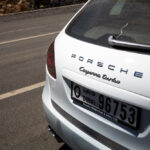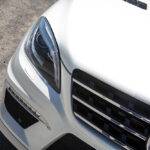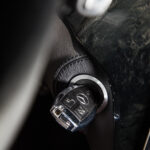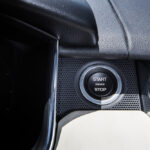The Good, the Bad, and the Ugly
Features | EVO Middle East | crankandpiston
James pits the Range Rover Sport against a Mercedes-Benz ML63 AMG and a Porsche Cayenne Turbo in crankandpiston.com’s version of the famous spaghetti western.
Originally posted – 11 June, 2014 | crankandpiston.com
In 1966, Italian director Sergio Leone assembled an all-star cast for his now legendary Italian Western, set during the American Civil War. Clint Eastwood, the eponymous Good referred to only as ‘Blondie,’ denotes a subdued reverence and practicality that continues to draw fans to this day. Lee Van Cleef, the Bad, emphasised, thanks to an outlandish and abrasive style, an aggressive power that fascinated many. And Eli Wallach, the Ugly, was the comical oaf, difficult to take seriously at first but an entity that would become more significant and popular as time wore on. At loggerheads throughout, the protagonists eventually settled their differences in a climactic three-way standoff. Today, in our very own ghost town high in the mountains, The Good, the Bad and the Ugly prepare for a whole new kind of showdown.
Heading our sporty SUV group is the brand new Range Rover Sport (our eponymous Good), which is flanked by the Mercedes-Benz ML63 AMG (the Bad), and… a shameless joke at Porsche’s expense, the Cayenne Turbo (the Ugly). All boast similar power. All are similarly priced. And all have proven a smash in their respective showrooms.
But which of our trio will emerge victorious from our standoff? Which of the three will find the unmarked grave and find the $200,000 of stolen Confederate gold in Sad Hill Cemetery? Which of our three is the best?
That’s your cue to start whistling…
Despite the early morning hours, temperatures in Dubai have already hit the low 40s as our convoy rolls out of Dodge towards the mountain range almost 150km away. For the opening leg, I am joined by crankandpiston photographer Arun in the Porsche Cayenne Turbo. True, had I thought ahead, I would have started in the Good (the Range Rover) and left the Porsche until last for chronology sakes. Unlike our other two sports SUVs here today though, this particular Cayenne is the actual car of Porsche Middle East and Africa’s CEO. Scrapes, scuffs and dings will therefore go down like the proverbial lead balloon, which means we have to be even more careful than normal on today’s shoot.
Understandably, the other members of our team – contributor Steve Smuts in the Merc. and crankandpiston digital team John and Cedrick flanking us in the Range Rover – are loathe to climb aboard the Porsche just yet.
Our trio skips most of the commuter traffic heading out of the city towards our neighbouring emirate to the north, and given that this is the Middle East, the sight of SUVs and 4x4s is a frequent one. Where our convoy differs however is the balance between off-road capabilities and dynamic handling on winding mountain asphalt. A stiffened chassis, reconfigured suspension and lowered ride height are all well and good, but if they’re too low or too tight, the essential DNA of an SUV, namely comfort and practicality, is irreparably damaged.
On the almost endlessly straight and monotonous highway network though, Porsche seems to have found a good balance thanks to comfortable leather seats and enough bounce in the suspension to massage bumps and kinks out of the ride: it even gives Arun the freedom to get some practice motion shots done on the highway.
My focus meanwhile is on the driving position, and again, with plenty of head and legroom and a cocooned driving position (thanks in part to the enormous transmission tunnel between the front seats), it’s a good balance between dynamic and practical. Regrettably it’s not all sunshine, roses and chewed cigar ends. The button-fest centre console is needlessly complicated to navigate, the turnkey start switch by my right knee looks like it’s trying too hard to be retro, and the grab handles on the centre console do sometimes make life difficult: somewhere I could leave my phone and wallet whilst driving, as opposed to something I keep constantly cracking my knee against as I get in, would be preferable.
We manage to avoid angry Confederate brigades on our way to the first stopping point for fuel. It’s here that we conduct an impromptu test of the rear doors amidst confused looks from the petrol station attendees. Turns out that whilst the boot can be opened and closed from the keyfob on both the Range Rover and the Mercedes, it cannot on the Porsche.
That’s just the start of our cut-throat bounty hunting showdown. And standing as we are in the shadows of the Ras Al Khaimah mountain range, it’s also an ideal time to give our trio the once over.
It’s not the strongest of starts for the Porsche. In fairness, the elongated headlights and air-intakey front bumper are a remarkable improvement over the Mk.1 Cayenne, but it’s a look that’s still difficult to love. The 911-esque styling feels too forced, and as we found during the shoot, there’s little else that draws the eye, thanks to a slightly too-subtle rear and smooth bodylines. The Range Rover meanwhile, though hardly shouty itself, boasts a much more elegant design, complete with rippled bonnet lines, aggressively carved headlights and vented flanks. You might call it ‘aggression light’, and while it may not blow your shoulder holster off, it’s an effective look.
Sliding across to the Mercedes though, it’s an entirely different matter. There’s another level of brash outlandishness for our ‘Bad’ antagonist, courtesy of chromed detailing, a proportionally enormous front grille, and AMG emblems on seemingly every panel: the alloy wheels; the exhaust tips; the bootlid; the headrests; the floor mats; the doorsills. Each emphasises the raw power under the bonnet. Each a notch on the Mercedes’ Colt 45.
By far, the ML63 is the most aggressive and thus most distinctive of the three, peaking my curiosity enough for me to swap seats for the next leg through the mountain passes.
Compared with the Porsche a few moments earlier, there’s a big difference on the inside. Whilst the Cayenne finds a good balance between ride comfort and handling, Mercedes has gone all out for that sporty feeling. The lowered suspension and stiffer chassis over the 63’s ML base model provides a surprisingly low driving position, albeit at the expense of ride comfort, which is now a little too stiff: Steve, having fallen out of the Mercedes moments earlier feels somewhat relieved to have now taken up position in the Porsche behind Arun and I.
The 5.5-litre twin-turbocharged V8 under the bonnet – the most powerful of the three at 518bhp –growls its raw power as we climb further into the twisting ribbon of tarmac, though admittedly, the Porsche’s 500bhp 4.8-litre biturbo V8 is hardly dawdling behind us.
The punch of both off the line is quite remarkable (the Merc just nails it with that additional 18bhp), and the launch ia accompanied by an aggressive basey soundtrack and acceleration that doesn’t even think of waning until we’ll well on our way to the redline. The big difference between the ML63 and the Cayenne though comes down to the gearbox, and that stiffened ride. In the past I’ve made mention of the AMG seven-speed’s tendency to nanny in its efforts to protect the transmission from over-revving. Admirable and clever certainly, but the AMG system’s tendency to hold a gear rather than letting the driver change down entering some of the tighter turns can upset the balance, and any momentum you’ve picked up.
Oh there’s plenty of grip from those front tyres and the weighty(ish) steering does mean you’ll know exactly where you’re pointing the front end, but the inability to change down as and when you want to means the stopping power of those AMG-spec brake discs are going to be put to the test quite regularly.
The weight of the Merc also adds to its problems, the bulk of which lands on the ML63’s nose through many of the tighter corners, bringing understeer with it when the beans are really being given. The sheer grunt of the 518bhp V8 means that on the straights immediately out of the corners, the Range Rover and Porsche have no chance of keeping up. But through the corners, they’re breathing down the ML’s neck.
Indeed, following close behind, Steve in the Cayenne Turbo just keeps getting bigger in my rear view mirror through the tighter corners. Thanks to a much lower centre of gravity, it’s easy to see that sporty Porsche heritage in the Cayenne, as the Turbo is astonishingly nimble through the corners. Good weight distribution also helps offset any traces of understeer, allowing Steve to get the power down earlier out of the corners than I can in the Merc (then again, almost a full year under the Nissan GT Academy umbrella gives Steve a slight advantage too!).
There’s plenty of heft at the wheel too, allowing Steve to place the Cayenne’s front wheels where he wants them. The angry AMG may have the legs out of the corners, but there’s still plenty of grunt in the 500bhp twin-turbo V8 to offer linear acceleration and a reinvigorated oomph at mid rev-range. There’s not a doubt in my mind that were Steve not holding station, the Cayenne would be past and well on its way down the mountain by now.
Several stretches of photogenic mountainscape bring our hoon to a brief end whilst we set up the camera equipment. It’s also the perfect opportunity for us to make the final switch, with the Cayenne taking up camera car duties with John and Cedrick, Steve taking the bad-boy Mercedes under his wing, and I finally getting some time with our eponymous hero, the Range Rover Sport.
Ironically our ‘man with no name’ boasts the greatest pedigree of the three: compared with four generations and 44 years of the Range Rover, the ML debuted in 1997, whilst the Cayenne’s first appearance was five years later in 2002. Almost immediately though the sensation in the Sport is much ‘SUV’ier than ‘sporty’ as opposed to our other two contenders. My seating position for instance is much higher, as is the comparative centre of gravity, and my enthusiasm to throw the Sport at the winding tarmac is slightly dampened as a result. There’s also more focus on low range four-wheel drive and hill descent controls than either the Mercedes or Porsche, emphasising exactly how the Range Rover made its name.
As the turns become yet tighter, the balance of ‘SUV’ to ‘Sport’ begins to shift. Compared with the Porsche and the Mercedes for instance, there is much less ‘tinsel’ in the cabin, the key components being a touchscreen infotainment system, climate control rotary dials and a more minimalist centre console. I even have an armrest (and THOSE plastic paddle shifters). It’s all so minimalist yet comfortable – thanks to a silky smooth ride and good acoustics – that the ‘look at me’ visage of the Mercedes and the overly complicated nature inside the Porsche cannot meet. With a stretch of winding tarmac, the focus is simply on driving. So that’s what we do.
For an SUV measuring more than six-feet tall, the Sport is remarkably nimble thanks to a considerably lower base weight over its predecessor. Obviously some bodyroll kicks through the tighter turns, but there’s far less understeer than one might expect.
Confidence boosted, the speedometer needle begins to rise. Corners are taken more aggressively thanks to weighty steering and a good sense of balance. Even braking hard into the corners doesn’t upset the remarkable nimbleness of the Sport through the turns.
Under the grooved bonnet of the Sport lies a 510bhp 5.0-litre supercharged V8, delivering more power in the lower revs than its turbo-charged rivals, keeping me glued to the back of the Mercedes and the Porsche as we feed the power back in out of the corners. Even at the top, there’s little sense of overexertion by the V8 and no lag. Push the Range Rover Sport – a true-blooded SUV, no less – and it obeys.
The sun is beginning to set just above the mountain range, and for our final shots, the three contenders have formed a triangle, one LED headlight eying another. But which has drawn first in this three-way duel? Which will ride into the horizon, and which ends the day with its head in a noose?
As far as poise goes, the Cayenne tops our trio. Five decades of 911 heritage have been developed into the design well, ditto good weight distribution and a stiffened chassis for better handling, and yet, somehow, not at the expense of ride quality.
But the Cayenne doesn’t come out on top. So far I’ve been focusing on the sportiness of our three models, and it’s only as we begin to creep further off road that the pedigree of each model becomes more relevant. And therein ultimately lies the Mercedes and the Cayenne’s respective Achilles heels. With low ground clearance and porky kerb weights, it’s as we manoeuvre the ML63 and the Cayenne that we take the most care: should one of them ground out or get stuck, it’s going to take some time to get them out. No such qualms for the Range Rover, however: of the three, it’s the one all of us want to be driving across country.
It’s not just the effectiveness of the Range Rover off-road that has won us over either. Yes, with it’s brash looks, the Mercedes is undoubtedly the most distinctive, while the Porsche’s poise means it’s the one we’d all choose to take for a mountain-road thrash. And yet the Range Rover is elegant, functional, easy-to-use, and great for soaking up the kilometres. On road or off, it takes the terrain with aplomb – on the limit or otherwise – without feeling that’s it’s over-reaching. As an all-rounder, it tops both the Porsche Cayenne Turbo and the Mercedes-Benz ML63 AMG. And as a sporty SUV, that’s what we’re all looking for.
In 1966, Clint Eastwood galloped into the distance as the famous soundtrack began to play. Today, as the Middle Eastern sun begins to set over our sporty SUVs, Good has triumphed once again.
That’s your cue to start whistling…
Images | Awesome Group, Arun M Nair and Harisanker S
Features | EVO Middle East | crankandpiston | James Gent

























